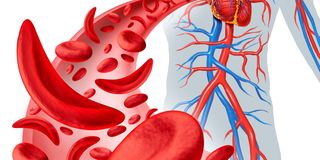Hope for patients as new sickle cell therapy is approved

A depiction of sickle-cells. A new form of treatment for sickle cell disease has been approved by a US-based drug’s regulator.
What you need to know:
- Lyfgenia is a cell-based gene therapy which uses a sort of gene transport system called a lentiviral vector to help in genetics.
Data from the Ministry of Health shows that about 14,000 children are born with sickle cell disease in Kenya every year.
A new form of treatment for sickle cell disease received approval from a US-based drug’s regulator, giving fresh hope to patients living with the ailment.
However, sickle cell patients in Kenya who spoke to the Nation are either not aware of the new drug. They feel that the drug is still far from reaching them.
The new approval comes a month after a United Kingdom medicine regulator approved a similar therapy, becoming the first in the world to do so.
Apart from the regimen that was approved in the UK, the US Food and Drug Administration (FDA) added one more option for sickle cell patients.
The world now has Casgevy and Lyfgenia as drug options for sickle cell patients aged 12 years and above.
The two drugs use a sophisticated cell-based therapy called CRISPR – one using conventional gene therapy and another, an advanced form of genome editing therapy.
“Gene therapy holds the promise of delivering more targeted and effective treatments, especially for individuals with rare diseases where the current treatment options are limited,” said Dr Nicole Verdun, director of the Office of Therapeutic Products within the FDA’s Center for Biologics Evaluation and Research.
The Centres for Disease Control and Prevention (CDC) explains that sickle cell disease is an inherited blood disorder which affects haemoglobin, a protein in our bodies that carries oxygen making red blood cells to appear C-shaped.
Modified blood stem cells
The FDA explained in a statement that Casgevy, which used CRISPR CAS 9, works by cutting out DNA in specific areas in a way that the faulty gene is expunged and then modified.
“The modified blood stem cells are transplanted back into the patient where they engraft (attach and multiply) within the bone marrow and increase the production of foetal haemoglobin (HbF), a type of haemoglobin that facilitates oxygen delivery. In patients with sickle cell disease, increased levels of HbF prevent the sickling of red blood cells,” explained the FDA in a statement.
Lyfgenia, on the other hand, is a cell-based gene therapy which uses a sort of gene transport system called a lentiviral vector to help in genetics.
“With Lyfgenia, the patient’s blood stem cells are genetically modified to produce HbAT87Q, a gene-therapy derived haemoglobin that functions similarly to haemoglobin A, which is the normal adult haemoglobin produced in persons not affected by sickle cell disease. Red blood cells containing HbAT87Q have a lower risk of sickling and occluding blood flow. These modified stem cells are then delivered to the patient,” said the FDA.
In the country, estimated data from the Ministry of Health shows that about 14,000 children are born with sickle cell disease every year.
Most infections in the country are domiciled in some of the Malaria endemic regions such as the coast, western and the lake region.
Dr Peter Marks, FDA’s director of the Center for Biologics Evaluation and Research said that the approvals represent an important medical advancement that will in the future be beneficial to public health.
“Today’s actions follow rigorous evaluations of the scientific and clinical data needed to support approval, reflecting the FDA’s commitment to facilitating the development of safe and effective treatments for conditions with severe impacts on human health,” he said.
However, the FDA said that the safety of the two forms of therapy is still being evaluated as patients who have already received the drug will be followed through in a couple of months.
White blood cells
“The most common side effects were low levels of platelets and white blood cells, mouth sores, nausea, musculoskeletal pain, abdominal pain, vomiting, febrile neutropenia (fever and low white blood cell count), headache and itching,” said the FDA, in reference to Casgevy’s possible risks.
For Lyfgenia on the other hand, the FDA reported that the common side effects are; stomatitis (mouth sores of the lips, mouth, and throat), low levels of platelets, white blood cells, and red blood cells, and febrile neutropenia (fever and low white blood cell count), consistent with chemotherapy and underlying disease.
Two pharmaceutical companies – Vertex Pharmaceuticals Inc. and Bluebird Bio Inc received approval from the FDA to sell and distribute the two new regimens.
Leah Kilenga, the Executive Director of Africa Sickle Cell Organisation, who also lives with sickle cell disease weighs in on the new therapy, saying that she is cautiously optimistic about African patients accessing it.
“As it stands, we still do not have access to the basic essential medicine and therapies that are proven to be working because of the low prioritization by governments in terms of policy and budgets," she said.
She told the Nation that Health systems need to be strengthened in Africa when it comes to providing sickle cell care.
“If we do not have access to the lower profile patient care, early access to diagnosis and linkage of care, essential medicines and chronic care management, then I do not think that the patients and the populations living with sickle cell will even be healthy enough to be able to be candidates for CRISPR,” she explained.
"Now, it seems like a pipe dream even though there is a hopeful light at the end of the tunnel. But, how realistic is it for us to achieve it, within the next 20 to 30 years if all these other things are not addressed," she added.






